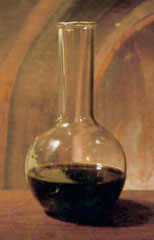History of Balsamic Vinegar
Balsamic vinegar has a very ancient origin which is lost in history. It is fair to think that the practice of making this particular vinegar was born almost by chance, maybe after another typical product, Saba or Sapa, a sort of cooked must, was left in some remote wooden container in which, little by little, a liquid was embryonically formed which had vaguely the acetic and aromatic characteristics of our balsamic vinegar.

If we want to get away from conjectures and refer to reliable documents we have to go back to the 12th century, with the Benedictine monk Donizone, who for the first time talks about, in his “vita Mathildis”, dedicated to the famous countess Matilde di Canossa, about the request of emperor Arrigo III, passing through Piacenza, to her father, marquis Bonifacio, for a vinegar “that he had heard was made there very perfect”. The marquis responded to this prestigious request by sending a small silver cask on a cart pulled by oxen, containing the best of this precious liquid. That it was a gift highly appreciated by the emperor is proof of another gift, to be considered equally worthy of the king, made by a vassal contemporary of Mantua Bonifacio, one hundred horses bai equipped with saddle and bridle and two hundred hunting goshawks.
The domains of the House of Canossa extended mainly in the provinces of production of balsamic vinegar, Modena and Reggio Emilia. In order to see the word “balsamic” officially appear in any document, however, we will have to wait many years and arrive in 1747, the year in which it was written in the register of harvests on behalf of the Ducale Cantina Segreta Estense. However, in 1556, in a volume of the court, a precise list of the types of vinegars in use is given, from the common to the excellent one, reserved to noblemen.
 In 1863, Sestini stated: “In the provinces of Modena and Reggio Emilia, since ancient times, a particular quality of vinegar has been prepared, whose physical appearance and excellent aroma have earned it the name of Balsamic Vinegar. Among the titles of value of this product prevails that of its age; and great care is taken to authenticate it appropriately. Balsamic vinegars of 50, 70 or 80 years of age are considered good; those of 100, 120 or 150 years of age are excellent; and when they are 200 or more years old, there is nothing more to be desired! “.
In 1863, Sestini stated: “In the provinces of Modena and Reggio Emilia, since ancient times, a particular quality of vinegar has been prepared, whose physical appearance and excellent aroma have earned it the name of Balsamic Vinegar. Among the titles of value of this product prevails that of its age; and great care is taken to authenticate it appropriately. Balsamic vinegars of 50, 70 or 80 years of age are considered good; those of 100, 120 or 150 years of age are excellent; and when they are 200 or more years old, there is nothing more to be desired! “.
In the concomitant congress of the agrarian association in the same year 1863, it was mentioned a balsamic vinegar of the highest quality, 360 years old, which means that the practice of making balsamic vinegar was certainly in common use at the beginning of 1500. However, it is with Agazzotti, in 1862, that we have a sort of codification of “natural” balsamic vinegar through a famous letter which is still, after having removed marginal practices, the “manifesto” of balsamic vinegar.

